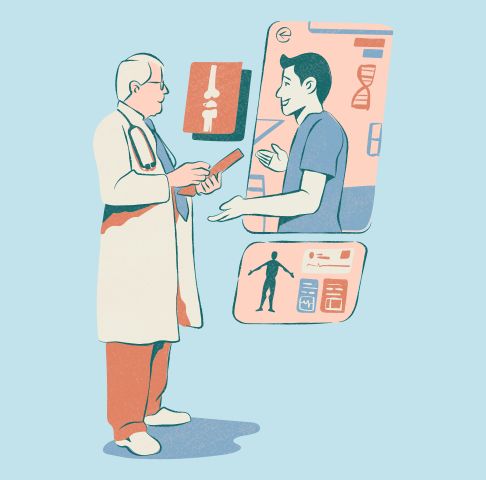Have you ever been called “lazy bones” as a kid when you refused to put away your toys or get out of bed? While you might laugh at the phrase, there comes a time when your bones do slow down in a way.
Most people reach their peak bone mass between the age of 25 and 30. By 40, we slowly begin to lose bone mass.1 That’s when bone loss happens faster than it’s replaced and your bones get weaker and less dense. These effects are compounded over time, increasing your risk of osteoporosis. We can, however, avoid severe bone loss over time by significantly slowing down bone loss through proper nutrition and regular exercise.1
This explains why calcium supplements are often recommended for adults over the age of 40.
If you’ve started paying more attention to your calcium intake for bone health, good on you. However, I want to know three things: Are calcium supplements really necessary to maintain bone health? Given the possible cardiac risk associated with calcium supplements2, is it still safe to take them? And, are there alternatives to calcium supplements?
I’ll explore these questions in this article.
Why is calcium important for strong bones and osteoporosis prevention?
Calcium is an essential mineral that builds and maintains strong bones, and we absorb most of our calcium through a good diet and natural sunlight3. What’s interesting is that over 98% of the calcium in your body is stored in your bones and teeth, and if you don’t get the recommended amount in your diet, your body will take it from your skeleton and teeth to use elsewhere, weakening your bones.4
Calcium is especially important during childhood to help with bone and teeth development, which is why you consumed lots of milk and dairy while growing up. In adulthood, calcium continues to be important. During your senior years, it becomes more crucial again, as older bones are more brittle and prone to fractures.
Particularly worrying is osteoporosis, a bone disease that causes thin and weak bones and increases the risk of severe fractures even with little trauma.
What is osteoporosis?
Osteoporosis is a fast-growing national health concern in a rapidly ageing country like Singapore5, alongside cancer, heart disease and diabetes which tend to affect the elderly. The International Osteoporosis Foundation Asian Audit showed that one in three Singaporean women over 50 years old has osteoporosis. Among women over 60 years, half were at intermediate risk and one-quarter were at high risk of developing osteoporosis. It’s estimated that the costs of managing hip fractures in Singapore will reach US$145 million in 2050.6
Age naturally increases one’s risk of osteoporosis, however, Singaporeans’ increasingly sedentary lifestyle only exacerbates the problem. For these reasons, it’s highly likely that osteoporosis will become more common in years to come, driving up the risk of fragility fractures which could lead to hospitalisation and disability.
Having adequate intake of calcium and vitamin D, is one way to maintain overall bone health, and prevent and treat osteoporosis.
How much calcium do you need? Are calcium supplements safe?
In case you’re wondering, here’s a guide to how much calcium you should aim to consume daily7:
Some people see calcium supplements as a convenient way to get their daily requirement. However, there have been reports that calcium supplements can increase the risk of heart disease.
Several studies show that calcium supplements can raise the risk of heart disease, especially in healthy post-menopausal women8. Some say that over-taking them can cause build-up of plaque which increases the risk of heart disease2. Other studies refute these claims altogether. The bottom line: scientists need to do more investigation into this supposed link between calcium supplements and the risk of heart attacks.
To stay safe, stick to the recommended dietary allowance for calcium in the table above unless otherwise advised by a medical professional based on your unique supplementation needs.
Supplement alternatives to protect bones and joints
If like me, you’d rather not wait for scientists to confirm or squash the calcium supplement-heart disease link and prefer to do things the natural way, here are three no-supplement ways to protect your bones and joints.
1. Eat sup tulang or other calcium-rich foods
Sup tulang or bone broth is one way to strengthen your bones. Commonly found in hawker centres, the aromatic stew of mutton marrow bones contains calcium and other nutrients which help to repair and build bone tissue and maintain bone density.
According to Healthline.com, the different parts of the bone in a bowl of bone broth can provide a host of nutrients, depending on their ingredients and quality. The bone itself contains calcium, phosphorus and other minerals; the marrow contains vitamins A, B and E, omega-3 and omega-6 as well as minerals; and the connective tissues contain glucosamine and chondroitin which are known to help with arthritis and joint pain.
However, because the calcium content in sup tulang and other kinds of bone broth isn’t standard depending on the amount and preparation method, it may not be sufficient as the only source of calcium for your daily needs.
That’s not to say you shouldn’t enjoy bone broth. For a healthy option, you can make your own sup tulang using recipes online. Alternatively, enjoy other types of bone broth made with fish, chicken, beef or pork bones.
Other good calcium sources to add to your diet include sardines, broccoli, leafy greens, beans and soya milk.
P.S. Don’t know how much calcium is in your food? Check out the Health Promotion Board’s Energy and Nutrition Composition tool for the exact numbers.
2. Bask in the sun
Getting regular exposure to sunlight is an easy way to get your daily dose of vitamin D, another essential mineral for optimal bone health. Vitamin D is crucial for your body’s absorption of calcium and together, these two nutrients keep your bones strong. They’re part of every successful action plan to prevent and treat osteoporosis.
The best time for sun exposure is after 10am, so head to a park or beach in the late morning, or step out of your office for a lunchtime walk. You can also consume more vitamin D-rich foods like salmon, milk and cheese.
3. Do weight-bearing exercises
Regular exercise helps to keep your whole body healthy but if you want to focus on bone and join health, be sure to include weight-bearing exercises in your fitness routine.
During weight-bearing activities, your muscles and tendons apply pressure on the bones, encouraging them to produce more tissue. As a result, the bones become more dense, reversing the effects of time on the bones and reducing the risk of osteoporosis.
Weight-lifting, running, playing badminton and skipping are some examples of weight-bearing exercises. They all involve being on your feet and working the muscles and bones against gravity. Any other activity that uses your body weight or equipment such as dumbbells to put force on the bone works – even light gardening or climbing the stairs or walking home with a bag of groceries. Do this for at least 30 minutes, two or three times a week.
Make no bones about it – taking action preserves your well-being
You need your bones to be in good shape so they’ll serve you well for your entire life. Taking active steps to get adequate calcium and vitamin D, doing the right exercises and getting a bone density scan are important for preventing osteoporosis, a debilitating disease which progress gradually and silently often without patients realising it until they suffer a painful fracture. So, if you’re thinking of what to eat today, do the bone-right thing and dig into calcium-rich foods, whether that’s a piping hot bowl of bone broth or something else!
Notes
1. Source: American Academy of Orthopaedic Surgeons, OrthoInfo, “Healthy bones at every age”, accessed on 25 October 2023.
2. Source: Harvard Health Publishing, “Could too much calcium cause heart disease?”, published on 28 February 2020.
3. Source: Cleveland Clinic, “Osteoporosis: Prevention with calcium treatment”, accessed on 25 October 2023.
4. Source: Healthline, “Calcium supplements: Should you take them?”, accessed on 25 October 2023.
5. Source: Agency for Integrated Care, “Introduction to osteoporosis”, accessed on 25 October 2023.
6. Source: National Library of Medicine, “Osteoporosis awareness among patients in Singapore – a community hospital perspective”, accessed on 25 October 2023.
7. Source: Health Promotion Board, Health Hub, “Recommended dietary allowances”, accessed on 20 October 2023.
8. Source: Mayo Clinic, “Calcium supplements: A risk factor for heart attack?”, accessed on 20 October 2023.








